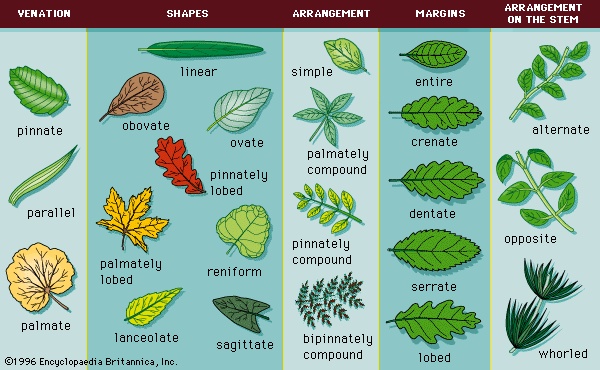leaf
plant anatomy
 in botany, any usually flattened green outgrowth from the stem of a vascular plant. Leaves manufacture food for plants, which in turn ultimately nourish and sustain all land animals. Botanically, leaves are an integral part of the stem system, and they are initiated in the apical bud along with the tissues of the stem itself. Certain organs that are superficially very different from the usual green leaf are formed in the same manner and are actually modified leaves; among these are the sharp spines of the Japanese barberry, pine needles, and the scales of an asparagus stalk or a lily bulb.
in botany, any usually flattened green outgrowth from the stem of a vascular plant. Leaves manufacture food for plants, which in turn ultimately nourish and sustain all land animals. Botanically, leaves are an integral part of the stem system, and they are initiated in the apical bud along with the tissues of the stem itself. Certain organs that are superficially very different from the usual green leaf are formed in the same manner and are actually modified leaves; among these are the sharp spines of the Japanese barberry, pine needles, and the scales of an asparagus stalk or a lily bulb.Typically, a leaf consists of a broad, expanded blade (the lamina), attached to the plant stem by a stalklike petiole. Leaves are, however, quite diverse in size, shape, and various other characteristics, including the nature of the blade margin and the type of venation (arrangement of veins). Veins, which support the lamina and transport materials to and from the leaf tissues, radiate through the lamina from the petiole. The types of venation are characteristic of different kinds of plants: for example, dicotyledons have netlike venation and usually free vein endings; monocotyledons have parallel venation and rarely free vein endings. The leaf may be simple—with a single blade—or compound—with separate leaflets; it may also be reduced to a spine or scale.
The main function of a leaf is to produce food for the plant by photosynthesis. Chlorophyll, the substance that gives plants their characteristic green colour, absorbs light energy. The internal structure of the leaf is protected by the leaf epidermis, which is continuous with the stem epidermis. The central leaf, or mesophyll, consists of soft-walled, unspecialized cells of the type known as parenchyma. As much as one-fifth of the mesophyll is composed of chlorophyll-containing chloroplasts, which absorb sunlight and, in conjunction with certain enzymes, use the radiant energy in decomposing water into its elements, hydrogen and oxygen. The oxygen liberated from green leaves replaces the oxygen removed from the atmosphere by plant and animal respiration and by combustion. The hydrogen obtained from water is combined with carbon dioxide in the enzymatic processes of photosynthesis to form the sugars that are the basis of both plant and animal life. Oxygen is passed into the atmosphere through stomates—pores in the leaf surface.
 Chlorophylls (chlorophyll), green pigments, are usually present in much greater quantities than others. In autumn chlorophyll production slows as the days get shorter and cooler. As the remaining chlorophyll breaks down and fades, the colours of other pigments are revealed. These include carotene (yellow), xanthophyll (pale yellow), anthocyanin (red if the sap is slightly acidic, bluish if it is slightly alkaline, with intermediate shades between), and betacyanin (red). tannins give oak leaves their dull brown colour.
Chlorophylls (chlorophyll), green pigments, are usually present in much greater quantities than others. In autumn chlorophyll production slows as the days get shorter and cooler. As the remaining chlorophyll breaks down and fades, the colours of other pigments are revealed. These include carotene (yellow), xanthophyll (pale yellow), anthocyanin (red if the sap is slightly acidic, bluish if it is slightly alkaline, with intermediate shades between), and betacyanin (red). tannins give oak leaves their dull brown colour.Leaves are essentially short-lived structures. Even when they persist for two or three years, as in coniferous and broad-leaved evergreens, they make little contribution to the plant after the first year. The fall of leaves, whether in the first autumn in deciduous trees or after several years in evergreens, results from the formation of a weak zone, the abscission layer, at the base of the petiole. Abscission layers may form when leaves are seriously damaged by insects, disease, or drought. Their normal formation in autumn appears to be, in part at least, due to the shortening of the day. Perhaps the shorter days accentuate the senile changes normal in older leaves. As a result, a zone of cells across the petiole becomes softened until the leaf falls. A healing layer then forms on the stem and closes the wound, leaving the leaf scar, a prominent feature in many winter twigs and an aid in identification.